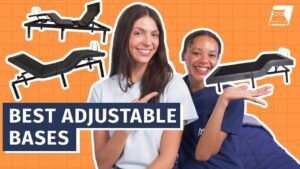Adjustable Bed Sleeping Positions
The right sleeping position on an adjustable bed could be beneficial to your health.
Disclosure: By clicking on the product links in this article, Mattress Nerd may receive a commission fee at no cost to you, the reader. Read full disclosure statement.
Adjustable beds aren’t just a comfortable place to sleep and a way to raise your head or feet. They may also provide various benefits to your health, no matter your preferred sleep position.
Sleeping strategically could result in getting a deeper, more restful night’s sleep. Here, we’ll review the different functions available in adjustable beds, sleeping positions for adjustable beds, and how all of this could benefit you and your health.
Sleeping Head Elevated on an Adjustable Bed
How to do it
Sleeping with your upper body in an incline position is often a great way to sleep better. But how much of an incline depends on your comfort level. Some can’t sleep at any elevated angle, while others rely on multiple pillows or high pillow loft to gain more height. An adjustable bed setting in the middle is likely your best bet.
What it’s good for
Catching forty winks with your head elevated can help manage symptoms of many chronic health conditions. Let’s review these and look at what the research says about each:
- Obstructive sleep apnea (OSA). Sleeping flat can worsen symptoms of OSA. Recent studies show improved airflow when lying in a 45-degree elevated sleep position.
- Snoring. Increasing your bed head at a 12-degree incline may help reduce snoring and improve sleep quality.
- Glaucoma. Raising the head helps lower intraocular pressure and reduce visual field loss in those with glaucoma.
- Gastroesophageal reflux disease (GERD). Lying on the left side with the head elevated helps reduce reflux symptoms at night.
- Chronic obstructive pulmonary disease (COPD). Sleeping upright to around 60 to 90 degrees may help improve airflow, which could help those with COPD breathe and sleep better.
Who it’s good for
An adjustable bed with the head at an incline can also benefit all types of sleepers. For example, take a look at the following groups of people:
- back sleepers: they may find an increasing amount of spinal support and see a reduction in heartburn symptoms.
- side sleepers: sleeping on either side at a slight incline might help you to breathe easier.
- couples: split adjustable beds allow couples to independently elevate their side of the bed to their comfort level.
Sleeping Feet Elevated on an Adjustable Bed
How to do it
For best results, consider elevating your legs above the level of your heart. Gravity helps move any built-up fluid from your legs back towards your heart to improve swelling and relieve pain.
What it’s good for
Other conditions also benefit from this sleep position. They include:
- poor circulation: putting your feet up helps the blood to flow more easily
- muscle tension: soreness in the lower body may ease by elevating the legs at night
- pressure relief: veins in the legs might feel a relief of pressure in an inclined position
Who it’s good for
The following individuals may benefit from sleeping with the foot of the bed elevated:
- pregnant people: Anecdotal evidence shows laying with your feet elevated may boost circulation and lessen swelling during pregnancy.
- active jobs: If you work on your feet all day, elevating your legs at night may help reduce swelling and discomfort.
- people with diabetes: Symptoms of diabetic neuropathy might become more manageable by putting the legs at an incline to help extend the spine and ease the pressure of the nerves in the legs and feet.
Zero Gravity Sleeping on an Adjustable Bed
How to do it
Also known as “zero gravity,” sleeping with your head and feet up is achievable with an adjustable bed. Some feel it allows you to fall asleep quicker and stay in that slumber longer.
What it’s good for
Some may find this position less comfortable than others, especially side sleepers. But there are benefits to sleeping with both the head and bed elevated. It could help relieve tension and swelling in the back and lower part of the body.
Who it’s good for
Sleeping on a bed adjusted to the zero-gravity position benefits your health if you experience the following:
- snoring
- heartburn and acid reflux
- insomnia
- poor circulation
- indigestion
Takeaway
Adjustable beds have the potential to positively impact your health. Different sleeping positions offer specific benefits and drawbacks. Practicing good sleep hygiene is a way to further ensure you get the blissful slumber your body needs.
If you’re pregnant or living with a chronic condition, it’s always best to speak with your doctor about how best to utilize an adjustable bed to fit your needs. Feel free to review some of our great tips to help you get a better night’s sleep in general.
Frequently Asked Questions
What’s the best way to sleep with an adjustable bed?
While sleeping with your head or legs elevated come with specific benefits, the answer is what fits you in terms of comfort and your health. Different people have their own needs and sense of their optimal sleeping position. You may also try different positions and angles to find the right one.
Can you sleep on your side on an adjustable bed?
Adjustable beds are capable of working well for side sleepers, as long as the elevation works for you. If you have back or hip pain, sleep apnea, or acid reflux, raising your head and feet might help to keep your spine aligned and ease discomfort.
Can you sleep in zero gravity position on your side?
You can raise both your head and feet while sleeping on your side, though potentially not to the highest elevation. You’ll want to ensure your spine isn’t misaligned since it can lead to interrupted sleep and pain.
Is it good for your back to sleep on an adjustable bed?
Lying flat might increase the pressure on your back and joints. So, if you have lower back pain caused by sciatica or other conditions, sleeping on an adjustable bed may help to lessen the stress and decrease pain.
Sources
5 health benefits of elevating your legs. (2020). https://www.merricksurgical.com/blog/post/5-health-benefits-of-elevating-your-legs-
Basoglu O, et al. (2015). Effect of semirecumbent sleep position on severityof obstructive sleep apnea in patients with heart failure. https://www.onlinejcf.com/article/S1071-9164(15)00180-3/fulltext
Dagli U, et al. (2017). The role of lifestyle changes in gastroesophageal reflux diseases treatment. http://acikerisim.baskent.edu.tr:8080/handle/11727/3380
Danoff-Burg S, et al. (2022). Sleeping in an incline position to reduce snoring and improve sleep: In-home product intervention study. https://formative.jmir.org/2022/4/e30102/#table2
Elevate to alleviate: How can leg elevation help during pregnancy? (2022). https://www.loungedoctor.com/blogs/news/elevate-to-alleviate-how-can-leg-elevation-help-during-pregnancy
Hecht I, et al. (2016). Modifiable factors in the management of glaucoma: A systematic review of current evidence. https://link.springer.com/article/10.1007/s00417-016-3518-4
Myers A. (2022). Best adjustable bed positions. https://www.mattressclarity.com/adjustable-beds/adjustable-bed-positions/
Patel P, et al. (2021). A comparison of effect of semi-fowler’s and side lying position on pulmonary functions and oxygen saturation in bedridden patients. https://www.ijhsr.org/IJHSR_Vol.11_Issue.5_May2021/IJHSR07.pdf
Shortness of breath management (ambulatory). (2022). https://elsevier.health/en-US/preview/shortness-of-breath-management


